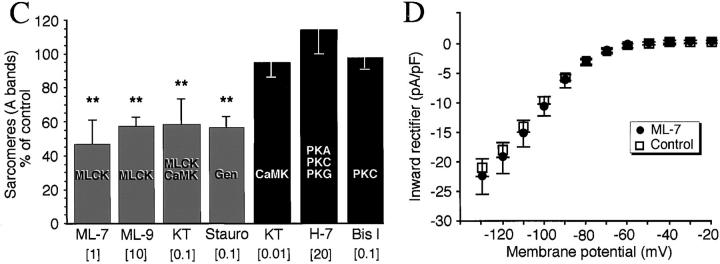Figure 3.
Pharmacological inhibition of MLCK disrupts A band formation. All data are from 24 h cultures. (A) Staurosporine (100 nM), a general kinase inhibitor, inhibits thick filament assembly without disrupting bipolar morphology. Myosin is diffusely distributed throughout the cells, with regions of dense accumulation. (B) ML-7 (1 μM), a specific MLCK inhibitor, disrupts myosin incorporation into A bands without affecting bipolar morphology. Myosin is distributed diffusely throughout the cells with localized dense patches. (C) Summary of kinase inhibitor effects on A band assembly. Inhibitors were applied at the concentration indicated (μM) to block the listed kinase(s). Note that KT5926, which inhibits CaMK II with high specificity (10 nM), has no effect, whereas a higher concentration (100 nM) of this agent inhibits MLCK as well, producing the same effects as ML-7 and ML-9. KT, KT 5926; Stauro, staurosporine; Bis I, bisindolylmaleimide 1. (D) Development of the inward rectifier potassium current is unaffected by 6–24 h, 1 μM ML-7 when assayed at 24 h in culture. Bars, 20 μm.


